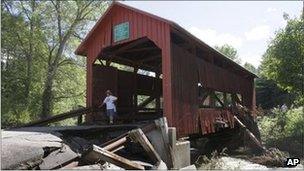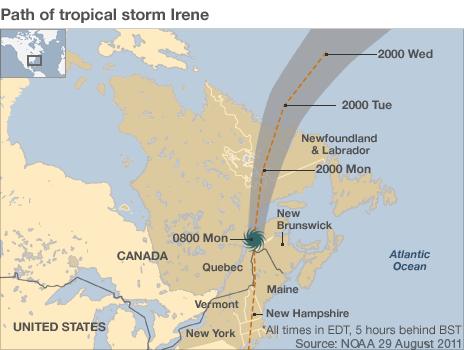Irene: Death toll reaches 40 as recovery begins
- Published
The floods caused chaos in New Jersey and Vermont
Post-Tropical Cyclone Irene has killed 40 people in the US, and authorities warn that flooding could continue for up to three days in northern US states.
More than five million people remain without power, while Vermont is reeling from its worst floods in many decades.
Insurance claims could top $7bn (£4.3bn), the Consumer Federation of America estimated.
Irene has passed into Canada, after causing havoc on the US east coast from North Carolina to Vermont.
Driving rains and flood tides damaged homes and cut power to more than three million people in New Jersey, Connecticut and New York alone.
Vermont governor lashes out
Homeland Security Secretary Janet Napolitano and Agriculture Secretary Tom Vilsack will visit North Carolina and Virginia on Tuesday to survey the storm damage.
Scott Snyder from the American Red Cross: "Some rivers are still rising"
Federal Emergency Management Agency chief Craig Fugate will head to Vermont.
In north-eastern Canada the first possible Irene-related fatality has been recorded.
A man was swept away in Yamaska, north-east of Montreal, as two cars plunged into a chasm created when a road was washed away, Quebec police said.
Nearly a quarter of a million people in Quebec, which saw winds as high as 62mph (100km/h), lost power on Sunday night.
An Associated Press news agency tally found 40 people had been killed in 11 US states, mostly because of falling trees, ocean waves, downed power lines and raging floods.
In the rural state of Vermont, the last to be hit before Irene reached Canada, the storm washed away bridges and swamped the town of Brattleboro.
Touring the town, Governor Peter Shumlin criticised media coverage for focusing on New York, saying: "We're not Manhattan, but we have human lives here in Vermont, too."
"It breaks your heart to see the extraordinary devastation that we're seeing here in Vermont," he said.
Hundreds stranded
Three deaths in Vermont have been blamed on the storm.
In the town of Waterbury, Irene closed the Vermont Emergency Management headquarters and the Vermont State Hospital, where some 50 patients were moved to other facilities.
Authorities asked people to avoid travelling in the state, which received 11in (28cm) of rain, and warned of significant flooding, damaged roads and downed power lines.
The storm caused part of a ski lodge to collapse in the town of Killington, where as many as 300 guests and 100 staff were stranded on Monday due to flooded roads.
Meanwhile, nearly 100 people remained stranded in mountain towns in New York State due to washed out roads and bridges. The storm dumped 13in of rain on the state.
New York Governor Andrew Cuomo said dozens of bridges and roadways would need to be repaired and that some of the state's rivers had yet to crest from flooding.
"You're going see more damage before it starts to get better," he told reporters.
In New York City, which escaped the worst of Irene's fury, the subway network and three main airports all reopened on Monday.
More than 300,000 people evacuated from low-lying areas in New York City are now able to return home.
Refunds demanded
Since Saturday, Irene has been downgraded from a hurricane to a tropical storm and now a post-tropical cyclone.

Creeks and rivers overflowed their banks and destroyed bridges and roads in Vermont
Some Americans who bought candles, canned food and other emergency provisions in recent days have been demanding refunds, claiming Irene's threat was exaggerated.
Claims for wind damage are expected to be one sixth of the total sum from Hurricane Katrina in 2005, and claims for flood damage one tenth, the Consumer Federation of America estimated.
Connecticut Governor Dannel Malloy said on Monday that more homes were without power as a result of the storm in his state than at any other time in its modern history.
States south of New York, where Irene struck at hurricane strength on Saturday and Sunday, have begun cleaning up, assessing the damage and counting the dead.
North Carolina Governor Beverly Perdue said some areas of her state were still unreachable. TV footage showed fallen trees and power lines.
Officials in Virginia have begun the clear-up, but say the damage was not as bad as feared.

- Published29 August 2011